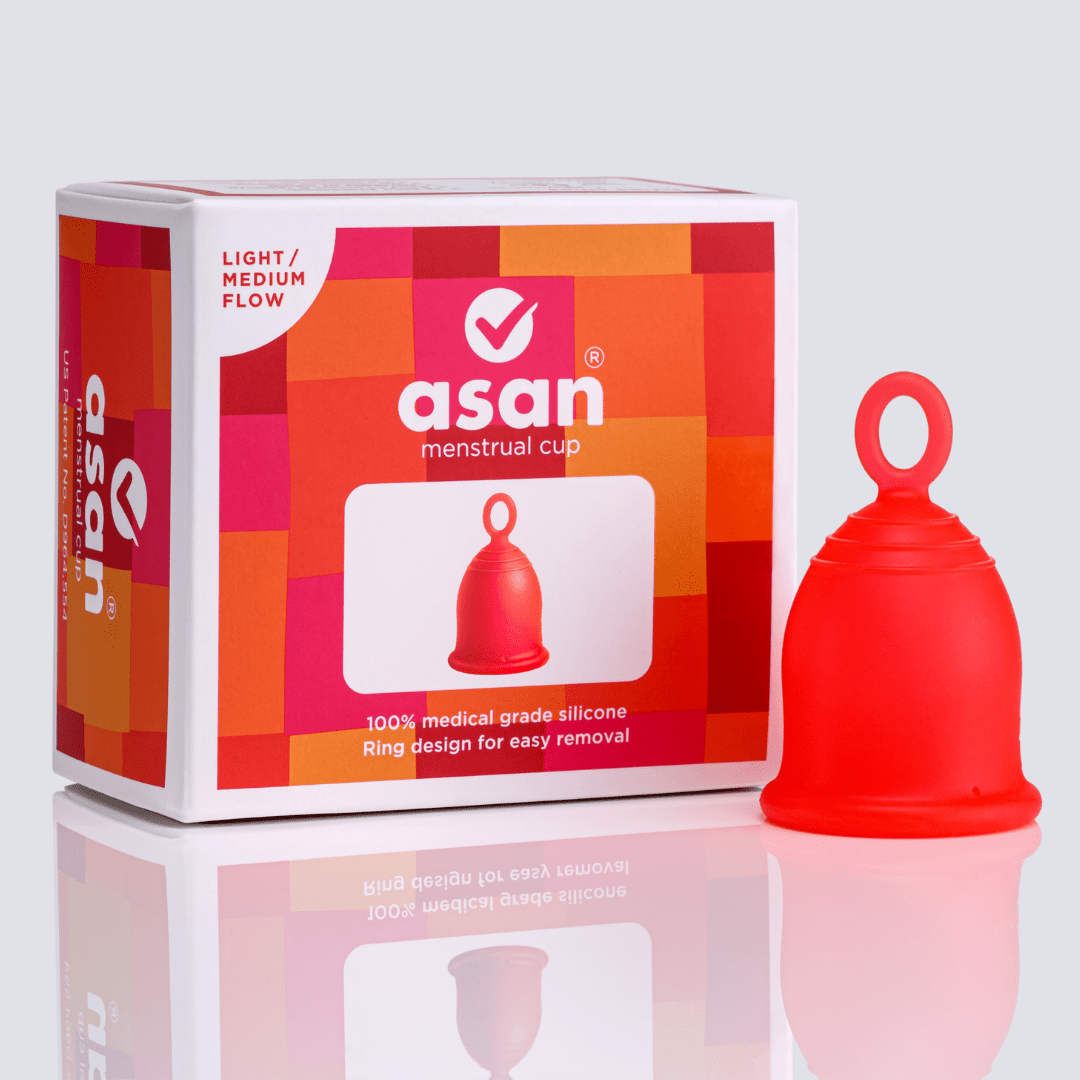 Have you heard about a menstrual cup but are wondering what exactly it is?
Have you heard about a menstrual cup but are wondering what exactly it is?
A menstrual cup is a sustainable and comfortable alternative to single-use period products such as sanitary pads and tampons.
With growing awareness around the importance of living an eco-friendly lifestyle, menstrual cups have been gaining a lot of popularity recently and are a preferred period product choice by thousands of women around the world.
So in this blog, let's address your confusion about what a menstrual cup is, its pros and cons, and how it works - so that you can make an informed decision for your body and the environment.
What is a menstrual cup?
A menstrual cup is an insertable period product that is used to collect your period flow during menstruation.
It is a bell-shaped device that is inserted into your vaginal canal. It sits in your canal to collect your period flow that travels from your cervix.

What is a menstrual cup made from?
While most menstrual cups are made from silicone material, some are also made with thermoplastics or latex.
Silicone comes in various Class specifications which tells you about the quality of the cup.
The Asan cup is made from Class VI medical grade silicone, which is the highest grade silicone that can be used to make menstrual cups. It is the same material used in heart stents and breast implants, so it’s biocompatible and super safe for you.
 We highly recommend doing your research and going for a high quality medical grade silicone menstrual cup.
We highly recommend doing your research and going for a high quality medical grade silicone menstrual cup.
What are the advantages of using a menstrual cup?
There are many advantages of using a menstrual cup. A few menstrual cup benefits include:
- Leak-free protection for up to 12 hours before you need to empty and re-insert your cup.
- Very comfortable for swimming, exercising and doing yoga while on your period.
- A menstrual cup is reusable and can be used for up to 10 years.
- Prevents rashes, discomfort, itching and vaginal infections.
- Unlike sanitary pads, you can't even feel a menstrual cup inside you once you’ve inserted it.
Feeling excited after hearing about how amazing menstrual cups are? Watch this video below to see a gynaecologist's opinion on menstrual cups.
How does a menstrual cup work?
Learning how to use a menstrual cup takes patience and practise.
It works using a suction mechanism to prevent menstrual cup leakage - where the rim of the menstrual cup creates suction with your vaginal canal once it has been inserted.
Once you’ve inserted your cup, you can comfortably go about your daily activities and you won't even feel the cup inside you!
When it comes to menstrual cup removal, you need to insert a finger and locate the stem or ring of the cup to bring it to the base of your vagina. At this stage the most important thing to remember is to pinch the base of the cup to release the suction - after which the cup will easily start coming out.
Read this blog to learn the step-by-step process of how to use a menstrual cup for beginners.
The #1 tip while using a menstrual cup is to be relaxed, try the cup in a comfortable space at home and when you have plenty of time in hand.
What are some menstrual cup folding techniques?
If you’re wondering how to insert a menstrual cup, you’re not alone! Initially menstrual cup insertion can seem a little confusing. But don’t worry! It’s a lot easier than it looks.
So let’s talk about the different types of folds you can use to comfortably insert your cup.
The two main folds are the C-fold and the punchdown fold.
 Once you have folded the cup in either of the above folds, make sure to have a tight grip on your cup as you push it inside your vaginal canal at a 45 degree angle. Once it is inside you, it will pop open and create a seal with your canal.
Once you have folded the cup in either of the above folds, make sure to have a tight grip on your cup as you push it inside your vaginal canal at a 45 degree angle. Once it is inside you, it will pop open and create a seal with your canal.
You can also read this blog to learn about all the different types of menstrual cup folds.
If you are new to menstrual cups, we recommend starting with the punchdown fold as it has a smaller insertion point - making it easier to insert.
How do I choose the right size menstrual cup?
If you are confused about how to choose the right menstrual cup, don’t worry! We’ll explain everything you need to know to find your perfect fit.
Menstrual cup sizes vary depending on the brand of your cup. Many menstrual cup brands around the world have based their sizing on your age, whether or not you’ve given birth, or your cervix height.
However, Asan found that these sizing guidelines can be inconsistent as everyone’s body is unique - despite your age, cervix height and whether you’ve given birth.
That’s why at Asan, we’ve designed our sizing guide simply based on your period flow. Read this blog on how to choose your size to learn more.
 How do you clean a menstrual cup?
How do you clean a menstrual cup?
Are you wondering how to clean a menstrual cup? Well it’s very easy!
To clean a menstrual cup all you need to do is soak it in boiling water for 5-10 minutes at the start and end of your period. This will sterilise your cup and kill any bacteria and germs that may have touched the cup's surface.
During your cycle, simply empty the cup and rinse it with room temperature water before reinsertion.
You can also use Asan’s One-Drop cleanser to clean your cup as an alternative to boiling it. It’s particularly useful when you’re travelling or don’t have access to boiling water.
 The One-Drop cleanser is made with completely natural ingredients including lavender extract. It is completely safe for your vagina’s pH level and menstrual cups.
The One-Drop cleanser is made with completely natural ingredients including lavender extract. It is completely safe for your vagina’s pH level and menstrual cups.
Please make sure not to use any regular soap to clean your menstrual cup as this can be harmful for the cup and your body.
frequently asked questions
Can I use a menstrual cup if I have a low cervix?
Yes absolutely! There are many menstrual cups that will fit comfortably inside you even if you have a low cervix.
And it’s completely okay if the ring sticks out a little because you won’t feel it!
Here’s some tips for using a menstrual cup for low cervix:
- Cut the stem or ring of the cup off
- Don’t push the cup up too high
- Go for a menstrual cup with a smaller height
Read this blog on the best menstrual cup for a low cervix to learn more.
Are menstrual cups good or bad for you?
Menstrual cups are definitely good for you! They are a great way to stay in touch with your period flow and understand your body better.
A high quality menstrual cup is chemical-free and very safe for you to insert. As a menstrual cup can be used for up to 10 years, it’s not only good for your body but also for the environment.
Is a menstrual cup safe for a 12-year-old?
Yes definitely. You can use a menstrual cup at any age once you’ve started menstruating.
In fact, we have many teen Asan cup users who are loving their experience and have no issues using it at all!
What are the disadvantages of menstrual cups?
There are really no cons of menstrual cups! Using a menstrual cup is a life-changing experience because it makes your period so much more comfortable than you’ve ever known.
The only drawback is that making the switch to a menstrual cup is a learning curve - much like trying anything new. So it’s important to be patient with yourself. But rest assured, within 2-3 period cycles you’ll be a pro and never look back.
Are there any side effects of menstrual cups?
No, there are no side effects of menstrual cups.
Just make sure you do your research and pick a good quality menstrual cup that is safe for your body.
Can a menstrual cup cause a UTI?
No, not at all!
A menstrual cup is the cleanest option when it comes to period products because it collects your period flow, rather than absorbing it. This prevents any bacteria from growing and giving you infections such as a UTI.
Can I use a menstrual cup for postpartum bleeding?
No, please do not use a menstrual cup to manage your postpartum bleeding. As your body is recovering from a pregnancy during the postpartum phase, it needs time to heal and start menstruating again.
A menstrual cup should only be used to manage your regular periods.
Menstrual cup vs pads: which is better?
While pads are easy to use and doesn’t require a learning curve like menstrual cups, they can carry harmful chemicals and be uncomfortable to use.
Once you’ve learnt how to use a menstrual cup, you don’t even feel it inside you. And unlike pads you can reuse it for up to 10 years.
Read this blog to learn more about which product is best for you.
Menstrual cup vs tampons: which is better?
Both menstrual cups and tampons are insertable period products. However, while tampons absorb your blood, menstrual cups work by collecting your period flow.
A menstrual cup is definitely a more sustainable option as you can reuse it and not have to worry about disposal.
Check out this blog on tampons vs menstrual cups to learn more.
Menstrual cup vs menstrual disc: which is better?
Menstrual cups and discs are both made from medical grade silicone and are super safe for you.
A menstrual disc allows you to have sex while on your period, whereas a menstrual cup can be reused for much longer and is less messy.
To learn more about menstrual discs, read this blog on menstrual cups vs menstrual discs.
How do I choose a menstrual cup for heavy periods?
If you are someone with heavy periods, the most important thing to look out for is the firmness of the cup. A firm cup will ensure that the suction does not break no matter how heavy your flow is.
Asan’s Heavy flow cup is especially designed for women and girls with heavier periods. Its bell-shaped design and firmness ensures that it stays in place for 10-12 hours without any leakages.







